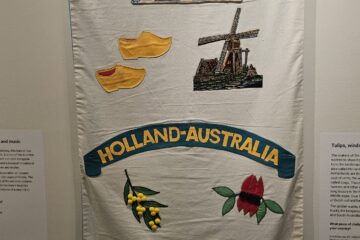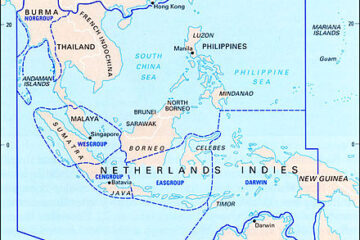Prelude
Following hastily established diplomatic relationships in January 1942, the Australian Labor Government offered the Dutch, after the fall of NEI, shear unlimited support in relation to facilities and training, while at the same time providing them with a remarkable high level of independence for their operations in Australia.
What became clear was that both countries were hopelessly unprepared for this war. The Dutch had nowhere near enough military equipment available in NEI and most of it was too old to be of any match to the modern gear of the Japanese military. Australia was equally unprepared as it hardly had any military forces available to protect itself in the north, its equipeert was also outdated and many of its soldiers were fighting for the Empire in North Africa.
Also from am organisational point both countries were also unprepared. The Netherlands had put their trust in their position of neutrality which worked in WWI and Australia depended to a large extend on British military leadership. Both countries were caught off-guard when Germany and Japan invaded their territories.
In relation to Australia, in 1941, before the Fall of Singapore, Britain had already secretly decided to concentrate its war effort to defeat Hitler and this left Australia very much on its own, a situation that worsened after further massive British, Dutch and American military defeats in SE Asia.
During the least few weeks before the Fall of NEI (which happened on 9 March), haphazard evacuations started to take place. In principle the order of the Dutch Government was to fight till the last man. However, those on the ground realised that this would be impossible. This was in contrast to the American evacuation of the Philippines. They started to organise this on February 23 and the actual evacuation to Australia happened on 1 and 3 March.
Some Dutch civil personnel and their families who were able to flee either by ship or plane started to leave in droves, this created an enormous chaos at ports and airports and most people were not able to leave the country. Against the orders of the Dutch Government several people fled the country who were ordered to stay till the bitter end. Other families had lived here for generations and therefore NEI was their home and had no where else to go.
Preparation for the in-exile situation
By mid February, the Governor the Netherlands East Indies Jonkheer (Lord) Alidius Tjarda van Starkenborgh Stachouwer ordered Lieutenant Admiral Conrad Emil Lambert Helfrich to evacuate to Ceylon in order to direct the Dutch Navy activities from here.
Days before the surrender he also ordered his Vice-Governor Hubertus van Mook to evacuate to Australia in order to start with the liberation of the NEI from there.
The Governor himself ended up in a Japanese Camp as well as all other European and Chinese people, in all more than 100,000 people. Prisoners of War were send to Japan, Burma and other parts of the newly occupied territories for forced labour, many died under the most terrible circumstances. The KNIL (Royal Netherlands East Indies Army ) was stood down and most of the native soldiers were allowed to go back to their villages. At the time of the surrender there were not more than 140 KNIL soldiers in Australia, who had accompanied Japanese POW to Australia. Later after the KNIL members of the guerrilla force from Timor were evacuated at the end of 1942, they were also added to the very small KNIL force in Australia.
Hubertus van Mook, Major-General Ludolph Hendrik van Oyen and other critical staff were evacuated from Java to Australia in 7 March 1942. They travelled on the floor of – the last DC-3 of the KNILM (civil aviation company) – the now famous Wielewaal.
This plane was on of three DC-3 planes (the other two being military) all taking senior staff essential for establishing a new command structure to Australia. All three planes landed safely in Australia. The total number of passengers on the three planes was approximately 70-80 people.
The last roundtrip of the Technical Department of the Air Force left Perth to an airstrip near Bandung on March 7. The DC-3 was commander by Gus Wincel.
Documents NEI Transfer of Government Officials to Australia – 1942
Researched by Ruby Todorovski, researcher University of Queensland
Netherlands East Indies Commission for Australia and New Zealand
The Netherlands East Indies Commission for Australia and New Zealand was established by the Dutch government-in-exile in London following the Japanese occupation of the Netherlands East Indies. The Commission’s purpose was to coordinate the Dutch civilian and military efforts in Australia and New Zealand and to provide support to the Dutch refugees who had fled the Japanese occupation.
The heads of Commission were Dr Hubertus van Mook, Deputy Governor General of NEI and his deputy Charles van der Plas, he was a Dutch colonial administrator who served as the Governor of East Java in the Dutch East Indies from 1936 to 1941.
The NEI Commission established seven Departments in Australia:
- Defence
- Netherlands Indies Civil Administration (NICA) for re-establishment of civil rule in reconquered areas
- Economic Affairs
- Education
- Home affairs
- Finance
- Public works
At the start, van Mook was also the official representative of the Netherlands East indies Government in Australia.
After their arrival in Australia, Dutch governmental staff set about establishing offices and organisations to undertake the many administrative tasks required, this in addition to the (limited) resources of the newly appointed Ambassador Baron van Aerssen Beyeren and Tom Elink Schuurman the existing Consul-General in Sydney, representing the Dutch Government in Exile, based in London.
Initially, there was insufficient personnel available, but eventually Dutch staff arrived from diplomatic posts in other countries. The NEI government-in- exile was formally known as the Netherlands East Indies Commission for Australia and New Zealand (NEICANZ) and was created in April 1942. Governor General van Mook brought also a few moderate Indonesian leaders to Australia. Among them was Colonel Abdulkadir Widjojoatmodjo. He was an Indonesian civil servant who later– on behalf of the Dutch – led parts of the Dutch-Indonesian independence negotiations.
NEICANZ looked after all of the NEI interests in Australia from there offices in Collins Street, Melbourne. By mid-1943, more premises had been acquired among them offices on St Kilda Road, Melbourne (where the KNIL headquarters was housed), and the ambassadorial residence and chancellery at 4 Mugga Way, Canberra.
As the head of NEICANZ van Mook preferred a progressive policy towards NEI, based on a Commonwealth arrangement with power sharing. The Dutch Prime Minister in exile Professor Gerbrandy (based in London) preferred a hard-line confrontation. This started to create tensions between the Australian Government and the Dutch Government in exile in London, as Australia was more sympathetic towards a slow change towards more independence for its northern neighbour. Furthermore. the US wanted to deal directly with the NEI Commission and Australia wanted to use the opportunity to independently of the Netherlands strengthen it ties with NEI .
The Dutch Government in London called van Mook back, to take up his former position of Miniater of the Colonies. In this way he would be less of a threat to the hard-line Dutch interest and the Dutch Ambassador Baron van Aerssen who was also appointed as the special Netherlands Minister for Australia. The latter’s aristocratic personally didn’t sit easy with the Australians and the relationship, especially later, with the post-war Labor Government, was often cool. He was the direct representative of the Dutch Government and as such could and could keep a close eye on any developments that could foster greater independence of NEI.
Nevertheless the Commission went ahead with its tasks, they created the Netherlands Indies Civil Administration (NICA) and the Netherlands Indies Army (NIA), which were tasked with governing and defending the Dutch East Indies after the war. They latter was later handed over to the military command.
The NICA was responsible for the administration of the Dutch East Indies, and included both civilian and military personnel. They were also responsible for providing relief and aid to the civilian population in the Dutch East Indies.
Some of the activities of NEICANZ included:
- Management of the overall activities of the commission, including budgeting, financial management, and reporting.
- Providing humanitarian assistance to Dutch refugees in Australia and New Zealand. It oversaw the distribution of food, clothing, and medical supplies and provided support for housing and education.
- Managing the complex personnel issues, There was an ongoing shortage of staff. Personnel was recruited from other posts, from the Dutch Caribbean Islands and from Australia.
- Promoting the Dutch cause and strengthening ties between the Netherlands and Australia and New Zealand. It organised cultural and educational events, published newsletters and other publications, and worked with the media to raise awareness of Dutch interests.
- Fundraising activities to support the Dutch war effort. It organised events and campaigns to collect donations from the public and facilitated the sale of Dutch goods in Australia and New Zealand.
Some of the Dutch facilities in Australia
| Dutch medical clinic in Kent St (near the Harbour Bridge). Princes Juliana Hospital Turramurra (now Juliana Lodge). NEI Airforce bases in Bundaberg, Brisbane and Canberra. Military base Casino. Port facilities: Brisbane, Sydney, Melbourne – naval HQ St Kilda Rd and depot in Middle Park, Freemantle (submarines). NICA – Melbourne first, later Brisbane. Lido, North Sydney and Belvedere at Kings Cross – clubs and accommodation for Dutch subjects. NEI government Information Service (NIGIS) in Melbourne. |
Major-General Van Oyen in charge of postwar reconstructions in NEI
Researched by Ruby Todorovski, researcher University of Queensland
See also: Netherlands Forces in Australia WWII
Navy and Army Intelligence Service
Next to the Dutch Navy – including the Merchant Navy and the Air Force the most important service the Dutch could offer to the war effort, was intelligence services, through its networks of people on the ground across the islands.
The services started off in 1941 as the Navy and Army Intelligence Service , based in Melbourne. In 1942 the name was changed into Netherlands East Indies Forces Intelligence Service (NEFIS). However, more and more the name used was Netherlands Forces Intelligence Service (still known as NEFIS). After the war this service would grow int the Dutch Commandos. An extensive overview of the organisation and its key missions is provided here here.
NEICANZ changed into the NEI Government-in-Exile in 1944.
The Legislative Council of the NEI Government-in-Exile – comprising of the directors of the seven , along with Van Mook could, if the need arose, be expanded to include 8 extraordinary members drawn from leading Dutch or ‘Indonesians’. Van Mook appointed the 7 directors on 12 April 1944. The directors held their first meeting in Melbourne on 23 May 1944. They had nine more meetings before reconvening at their new headquarters in Camp Columbia north of Brisbane on 23 August , from where the recolonialisation operation would be led. See: NEI Government-in-Exile in 1944-1946
Paul Budde
Links to other declassified WWII Australian Documents re the Netherlands East Indies


